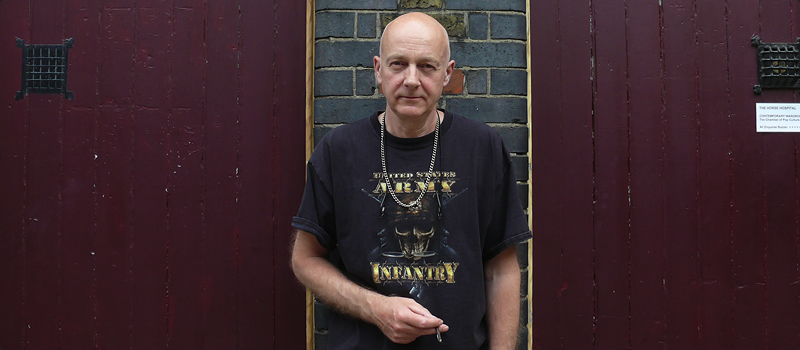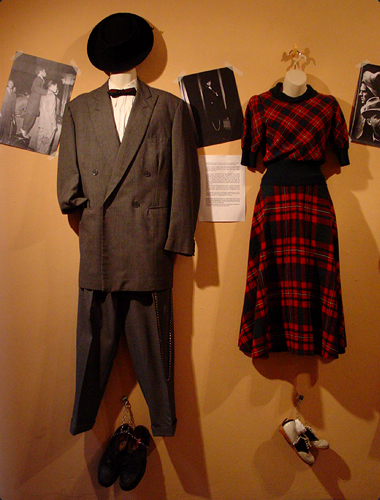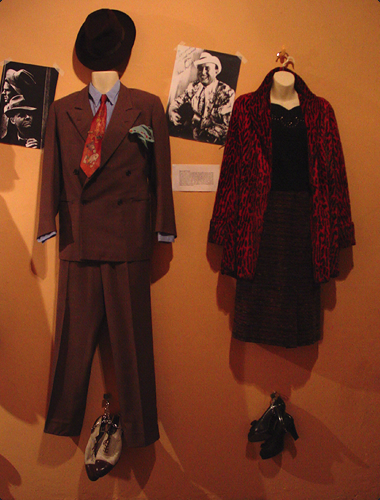STREET WEAR HISTORY
The guard of culture 'Roger K. Burton' talks about
the history of British Youth fashions
08 11/5 UP
Text:Andrew Bunney Translation:Mayumi Horiguchi


- Zoot Suit (1940s)
- The Zoot-suit thing kicked off in the 30s with Hispanic and Black kids taking on this look. Around jazz circles, bebop(n.5), jitterbug(n.6), new form of dancing. I don’t think it hit these shores until after the war, but with so many of these American fashions that ended up here, they came over on the boats with American Army, Navy and so on.
- L :
- I bought this one from a tailors in the East End back in the 70’s.
This would be worn on a Saturday evening going out. The owner was probably in a band or a dancer of some sort. - R :
- The same with the girl - very collegiate. Very much about this new music, designed with lots of flapping material.
- n. 5: bebop;
An early form of jazz. Originating around 1940. It is the general opinion that this form is the origin of modern jazz.
n. 6: Jitterbug;
The same as 'Lindy Hop' and 'Jive', it is a form of Swing dance. A strenuous dance performed to quick-tempo swing or jazz music and consisting of various two-step patterns embellished with twirls and sometimes acrobatic maneuvers. Japanese pronounce it as "Jiruba".

- Spiv (Early 40-50’s)
- These are particular favourites of mine. Probably not that youthful, but it was these guys that became nicknamed by the press ‘SPIV’, which is V.I.P.’S backwards, a play on cockney whatever. A lot of them were draft-dodgers and didn’t want to go to war. Whenever there was rationing, there was a black-market and they dealt in the black-market. Like a lot of stereotypical gangsters, they dressed in the most over-the-top stuff of the time. In grey Britain they were quite colourful really, and condemned for it. They ran all kinds of rackets from selling nylons to women and watched to guys, prostitution, call girls, theatrics and so on. They were quite extreme, and decadent – over the top. Very American influenced.

- New Edwardian (Late 40’s)
- This look came out of an initiative by the British Council in 1948 or ’49. After the war they put out a kind of contest to come up with a new look and a new silhouette for men.
- L :
- The Savile Row(n.7) tailors came up with this and called it a New Edwardian look. Mostly worn by Grenadier guards and people who could spend money on suits. This is basically a longer line jacket, with a velvet collar with a very Edwardian feel to it. They were quite shocking because it was something that nobody had seen before. You would see people wearing it around Mayfair(n.8).
- R :
- This outfit is a black suit from the late 40s, as there were still rationing, women were adapting clothes that they already had and changed the shape slightly.
- n. 7: Savile Row;
It is a shopping street in Mayfair, central London, famous for its traditional men's bespoke tailoring. The name is considered to be an etymology of "Sebiro" (=Japanese word for "Suit") .
n. 8: Mayfair;
It is an area of central London, England, within the City of Westminster. It is London's most exclusive & sophisticated district. There remains a substantial quantity of residential property as well as some exclusive shopping stores such as Burberry and British royal warranted jeweller's, and London's largest concentration of luxury hotels.


